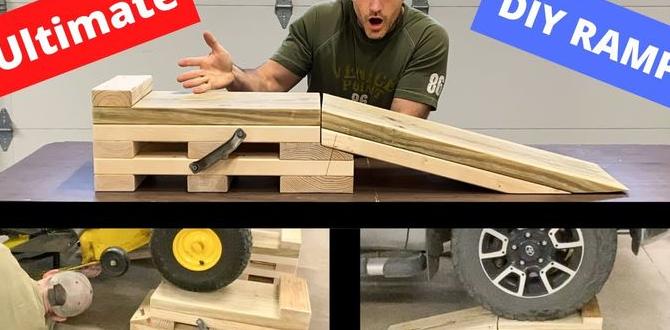Don’t let nail guns intimidate you! The best nail gun for DIY home improvement projects is the one that matches your task, budget, and comfort level. We’ll help you pick a reliable, easy-to-use model like an electric brad nailer or a cordless finish nailer to make your projects a breeze.
Hey there, DIYers! Jack over at Nailerguy here. Have you ever looked at a woodworking project, maybe a new shelf, a picture frame, or even a small garden planter, and thought, “I wish I had a faster way to put this together than hammering nails one by one?” You’re not alone! Many of us get a little stumped when it comes to choosing the perfect nail gun. It can seem like a big, complicated tool. But here’s the secret: it doesn’t have to be. With the right information, picking a nail gun for your DIY adventures is straightforward and even exciting. We’re going to walk through everything you need to know, from understanding different types to making your final choice, so you can tackle your projects with confidence and speed. Let’s dive in and demystify nail guns!
Table of Contents
Why a Nail Gun is a DIYer’s Best Friend
Hammering nails is a time-honored tradition, but let’s be honest, it can be slow, tiring, and sometimes a bit inaccurate. A nail gun, on the other hand, can dramatically speed up your projects. It drives nails quickly and consistently, giving you a more professional finish with less effort. Imagine attaching trim, building a small cabinet, or assembling a deck railing in a fraction of the time. That’s the power of a good nail gun! It’s not just about speed, though. Nail guns often drive nails flush or slightly countersunk, meaning less manual filling and sanding later. For any DIY homeowner looking to improve their home or build new things, a nail gun can be a game-changer, turning daunting tasks into manageable and even enjoyable ones.
Understanding the Different Types of Nail Guns
Nail guns aren’t one-size-fits-all. They come in different flavors, each designed for specific jobs. Knowing these differences is the first step to finding your perfect match.
1. Brad Nailers
Brad nailers are fantastic for delicate work. They use thin, small-headed nails (called brads) that leave a tiny hole, making them almost invisible.
Best for: Attaching delicate trim, molding, baseboards, chair rails, and smaller crafts. They’re also great for attaching trim inside cabinets or for furniture detail work.
Nail size: Typically use 18-gauge brad nails, which are thin and relatively short.
Pros: Minimal damage to the wood, easy to conceal nail holes, lightweight and maneuverable.
Cons: Not strong enough for structural framing or heavy-duty applications.
2. Finish Nailers
Finish nailers are a step up from brad nailers. They use slightly larger and longer nails, giving you a stronger hold for more substantial trim work.
Best for: Installing baseboards, crown molding, window and door casings, and general trim work where you need a good balance of holding power and a clean look.
Nail size: Usually use 15-gauge or 16-gauge nails. 15-gauge nails have a slightly larger head than 16-gauge, offering better holding power.
Pros: Good holding power for trim, leaves a relatively small hole that’s easy to fill, versatile for many interior finishing tasks.
Cons: Still not ideal for framing or structural joints.
3. Framing Nailers
These are the powerhouses. Framing nailers are designed for heavy-duty construction tasks. They drive larger, stronger nails deep into wood.
Best for: Building decks, framing walls, assembling fences, and any project that requires significant structural integrity.
Nail size: Use larger nails, typically .113 to .162 inches in diameter, and can range from 2 to 3.5 inches long.
Pros: Extremely powerful and fast for structural work, essential for heavy-duty construction.
Cons: Overkill for most DIY home projects, heavier, and requires more safety precautions.
4. Roofing Nailers
As the name suggests, these are specialized tools for attaching shingles and other roofing materials. They have a distinctive large magazine and a nose designed to drive nails flush with roofing surfaces.
Best for: Shingling a roof.
Nail size: Use large, galvanized roofing nails, usually 1 to 1.25 inches long.
Pros: Designed specifically for efficient roofing, fast nail driving.
Cons: Very specialized; not useful for general DIY projects.
5. Pin Nailers
These are the smallest and most delicate nailers. They use extremely thin headless or minimal-head pins, leaving almost invisible marks.
Best for: Attaching very small moldings, delicate trim, or in intricate craft projects where absolutely no visible nail marks are desired.
Nail size: Use very fine headless or minimal-head pins, often 23-gauge.
Pros: The most discreet fastening method available, ideal for invisible connections.
Cons: Very low holding power, only suitable for the lightest of tasks.
Choosing the Right Power Source for Your Nail Gun
Beyond the type of nail, how a nail gun is powered is a major decision point. Each has its own advantages depending on your workspace and project needs.
1. Pneumatic (Air-Powered) Nail Guns
These are the traditional workhorses. They require an air compressor and a hose to operate.
How they work: An air compressor stores compressed air, which is released through a hose to power the nail gun’s mechanism.
Pros: Generally the most powerful and lightweight at the gun itself, very reliable, and often more affordable for the tool itself (though you need a compressor).
Cons: Requires an air compressor (which can be bulky and noisy), a tethering hose limits mobility, and you need to manage air pressure settings.
Best for: Workshops, garages, or job sites where a compressor is readily available and mobility isn’t the primary concern. They are often favored by professionals for their consistent performance.
2. Electric Nail Guns (Corded)
These plug directly into a wall outlet. They are convenient for indoor use where an outlet is nearby.
How they work: An electric motor powers a mechanism that drives the nail.
Pros: No compressor needed, no setup time besides plugging in, relatively quiet operation.
Cons: Limited by the length of the power cord, can be heavier than some pneumatic models, and may not have the same driving power as pneumatic or high-end cordless options.
Best for: Smaller interior projects, quick fixes, or where access to an outlet is easy and portability isn’t paramount.
3. Cordless Nail Guns (Battery-Powered)
These are the most modern and often the most convenient for DIYers. They use rechargeable batteries, offering complete freedom of movement.
How they work:
Gas/Fuel Cell: Some models use a small fuel cell that’s ignited to drive the nail, assisted by a battery for fan and ignition.
Electric/Battery: Others use a powerful electric motor and a small air cylinder that is pressurized by the motor with each nail drive.
Pros: Ultimate freedom of movement (no cords or hoses), fast setup, no consumables like fuel cells (for battery-only models), increasingly powerful.
Cons: Can be heavier and more expensive due to the battery and motor, battery life is a consideration, and you need to keep batteries charged.
Best for: Almost any DIY project, especially where you need to move around a lot, work outdoors, or don’t want the hassle of a compressor and hose.
Top Nail Gun Recommendations for DIY Home Improvement Projects
Based on the needs of DIYers looking for versatility, ease of use, and reliability, here are some top contenders. Keep in mind that specific models change, so focus on the type and brand reputation.
1. Best All-Around for DIY: Cordless Finish Nailer
For most DIY homeowners, a cordless finish nailer (16-gauge or 15-gauge) is your golden ticket. It handles a vast majority of trim and finishing tasks with ease. Brands like DEWALT, Ryobi, Makita, and Metabo HPT (formerly Hitachi) offer excellent battery-powered options.
Why it’s great: Tackles baseboards, door trim, crown molding, and even wainscoting. The cordless freedom is a huge plus for moving around rooms or working on a deck.
Look for: Dual-action trigger (Sequential for precision, Bump for speed), tool-free depth adjustment, and good battery life.
2. Best Budget-Friendly Option: Electric Brad Nailer
If your projects are usually smaller crafts, picture frames, or light trim work and you want to keep costs down, an electric brad nailer is a solid choice. Brands like CRAFTSMAN, Stanley, and Arrow offer affordable, plug-in models.
Why it’s great: Very affordable, no need for batteries or compressors, lightweight, and easy to operate for simple tasks.
Look for: Decent power for at least 18-gauge brads, comfortable grip, and a safety tip to prevent accidental firing.
3. Best Versatility (if you already have a compressor): Pneumatic Combo Kit
If you’re looking to equip your workshop for a variety of tasks and you’re willing to invest in an air compressor, a pneumatic combo kit (often including a brad nailer and a finish nailer) can be very cost-effective. Many tool brands (Porter-Cable, DEWALT, Kobalt) offer these.
Why it’s great: Pneumatic tools are known for their power, durability, and often lower tool cost compared to high-end cordless. A combo kit gives you two versatile tools for the price of one or two individual cordless units.
Look for: A compressor that can keep up with the nailers (usually at least 2-3 gallons, oil-free for DIY ease). Ensure the nailers in the kit meet your needs for gauge and depth.
Table: Nail Gun Types vs. Common DIY Projects
| DIY Project | Recommended Nail Gun Type | Nail Gauge | Power Source Options | Key Features to Look For |
| :————————– | :———————— | :———– | :———————— | :———————————————————- |
| Installing Baseboards | Finish Nailer | 15 or 16 ga | Cordless, Pneumatic | Depth adjustment, dry fire lockout, comfortable grip |
| Attaching Crown Molding | Finish Nailer | 15 ga | Cordless, Pneumatic | Adjustable depth, good balance, slim nose |
| Building Shelves/Cabinets | Brad Nailer / Finish Nailer | 18 ga (Brad) / 16 ga (Finish) | Cordless, Electric, Pneumatic | Accurate driving, adjustable depth, lightweight |
| Crafting Picture Frames | Brad Nailer / Pin Nailer | 18 ga (Brad) / 23 ga (Pin) | Electric, Cordless, Pneumatic | Precision, small nail size, minimal marring |
| Deck Railings Assembly | Framing Nailer (if building deck structure) / Finish Nailer (if only railing) | 1.5-2.5 in (Framing) / 2-2.5 in (Finish) | Pneumatic, Cordless (Framing is less common cordless) | Power, nail length, safety features |
| Installing Window/Door Trim | Finish Nailer | 15 or 16 ga | Cordless, Pneumatic | Consistent nail depth, good for tight spaces |
Key Features to Consider When Buying Your First Nail Gun
Don’t get overwhelmed by all the options! Focus on these essential features to ensure you pick a tool that will serve you well.
Depth Adjustment: This is crucial. It allows you to control how deep the nail is driven. You want to be able to countersink nails slightly for trim work without driving them too deep and damaging the wood, or drive them fully for structural attachments. Look for tool-free depth adjustment; it’s much more convenient.
Sequential vs. Bump Fire Trigger:
Sequential Trigger: The gun only fires when the safety tip is pressed against the surface and the trigger is pulled. This is safer and allows for precise placement, one nail at a time. Great for detail work and beginners.
Bump Fire Trigger: The gun fires repeatedly as long as the safety tip is depressed and the trigger is held down. This is much faster but requires more practice to avoid accidental nail placement.
Dual/Selectable Triggers: Many modern nail guns offer a switch to choose between sequential and bump fire modes, giving you the best of both worlds. This is ideal for DIYers!
Dry Fire Lockout: This feature prevents the nail gun from firing when there are no nails left in the magazine. It saves wear and tear on the tool and prevents marring your workpiece with an empty firing. Look for this!
Ergonomics and Weight: You’ll be holding this tool, sometimes for extended periods. A comfortable grip, good balance, and manageable weight are important. This is especially true for cordless models where the battery adds weight.
Jam Clearing: Eventually, you’ll get a jam. How easy is it to clear? Most modern nail guns have tool-free jam release mechanisms, which are super handy.
Nail Compatibility: Make sure the nail gun you choose uses nails that fit your intended projects. Check the gauge (thickness) and length range.
How to Use a Nail Gun Safely – Essential Tips
Safety is paramount. Nail guns are powerful tools, and even a small nail can cause a serious injury if not handled correctly. Here are the non-negotiable safety rules:
1. Always wear safety glasses: Even if you wear prescription glasses, wear safety glasses over them. Nails kicked back or deflected can cause serious eye injury.
2. Never point the nail gun at anyone: Treat it like a loaded firearm. Do not disconnect the air hose (for pneumatic guns) or battery (for cordless) and then point it at yourself or others.
3. Keep your fingers away from the trigger and nose: Keep your non-dominant hand well clear of the firing zone.
4. Engage sequential firing when precise placement is needed: This is the default safe mode. Only use bump fire if you are experienced and confident in your control.
5. Ensure there is a nail loaded before engaging the safety tip: This prevents accidental firing.
6. Disconnect power when not in use or servicing: For pneumatic guns, disconnect the air hose. For electric/cordless, remove the battery or unplug it before performing maintenance, clearing jams, or changing nails.
7. Be aware of your surroundings: Make sure no one can walk into the path of a nail. Be mindful of where the nails will exit the workpiece; they can go through thin materials.
8. Read the manual: Every nail gun is slightly different. Familiarize yourself with your specific model’s features and safety guidelines. For more in-depth safety information, the National Institute for Occupational Safety and Health (NIOSH) and OSHA provide excellent resources.
Step-by-Step: First Use of Your New Nail Gun
Once you’ve chosen and safely handled your nail gun, here’s how to get it ready for its first use.
Step 1: Read Your Owner’s Manual
I can’t stress this enough! Every nail gun is different. This manual will cover specific setup, maintenance, and safety for your particular model.
Step 2: Connect Power
Pneumatic: Connect your air hose to the tool’s air inlet fitting and to your properly regulated air compressor. Ensure the compressor is set to the recommended PSI (pounds per square inch) for your nailer, usually found in the manual.
Electric (Corded): Plug the tool into a grounded electrical outlet.
Cordless (Battery): Ensure the battery is fully charged and properly inserted into the tool.
Step 3: Load Nails
Open the magazine (usually by sliding a mechanism or pulling back a spring-loaded follower).
Insert the correct type and size of nails. Make sure they are seated properly against the magazine’s backplate or pusher.
Slide the magazine closed until it latches securely. A good test is to gently pull on the follower; it should resist you pushing the nails out.
Step 4: Adjust Depth (If Applicable)
If your nail gun has depth adjustment, set it to the desired depth for your project. For most trim, you’ll want the nail head to be slightly below the surface. Start with a mid-range setting and test on a scrap piece of wood.
Step 5: Set Trigger Mode (If Applicable)
If your nail gun has selectable triggers, set it to sequential mode for your first few nails. This is the safest mode.
Step 6: Test Fire on Scrap Wood
Before working on your actual project, pick up a piece of scrap wood.
Hold the nail gun firmly with the nose pressing against the wood.
Gently squeeze the trigger. Make sure a nail fires and is driven to the correct depth.
If the nail is too deep, decrease the depth setting or lower the air pressure (for pneumatic).
If the nail isn’t deep enough, increase the depth setting or increase the air pressure (for pneumatic).
Fire a few more nails to confirm consistent performance.
Step 7: Begin Your Project
Once




